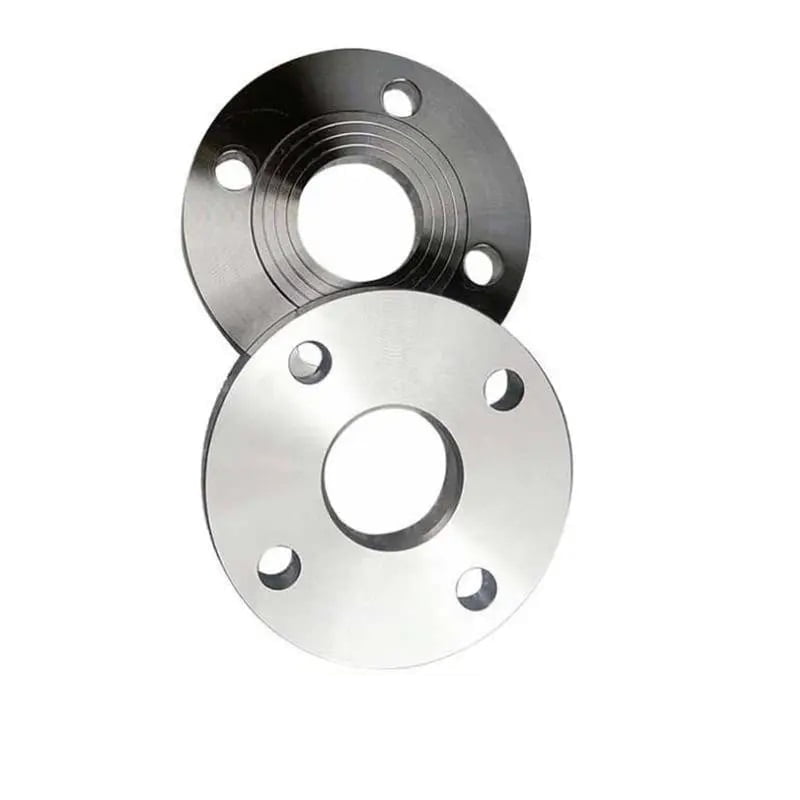
ニッケル基合金フランジは、優れた耐食性、高温取り扱い能力、優れた機械的強度などの優れた特性により、さまざまな業界で使用される必須の部品です。これらのフランジは、他の材料では破損するような厳しい環境で使用され、航空宇宙から化学処理に至るまでの分野での設置の信頼性と寿命を保証します。ここでは、ニッケル基合金フランジの詳細な側面を掘り下げ、その組成、特性、用途などを包括的に理解します。
ニッケル基合金の組成
| ニッケル合金 | ニッケル(Ni) | クロム(Cr) | モリブデン(Mo) | 鉄(Fe) | その他 |
|---|---|---|---|---|---|
| インコネル625 | 58% | 20~23% | 8-10% | 5% | Nb、C、Mn、Si、S、Al、Ti、Co |
| ハステロイ C276 | 57% | 15.5% | 16% | 5% | W、Co、V |
| モネル400 | 63% | – | – | 2.5% | Cu、Mn、Si、C、S、Fe |
| ニッケル200 | 99.6% | – | – | 0.4% | Cu、Mn、Si、C、S、Fe |
機械的性質
| ニッケル合金 | 引張強さ(MPa) | 降伏強さ(MPa) | 伸長 (%) | 硬度(ブリネル) |
|---|---|---|---|---|
| インコネル625 | 950 | 430 | 30% | 220 |
| ハステロイ C276 | 790 | 355 | 40% | 200 |
| モネル400 | 550-620 | 240 | 35% | 150 |
| ニッケル200 | 380 | 100 | 40% | 110 |
さまざまな温度でのパフォーマンス
| ニッケル合金 | 低温(-196℃) | 中温(500℃) | 高温(1000℃) |
|---|---|---|---|
| インコネル625 | 素晴らしい | 素晴らしい | 良い |
| ハステロイ C276 | 素晴らしい | 素晴らしい | 良い |
| モネル400 | 素晴らしい | 良い | 貧しい |
| ニッケル200 | 良い | 貧しい | 推奨されません |
産業用途
| ニッケル合金 | 業界 | 応用 |
|---|---|---|
| インコネル625 | Aerospace, Oil & Gas | ジェットエンジン、タービン、掘削リグ |
| ハステロイ C276 | 化学処理、発電 | 反応器、熱交換器、ボイラー |
| モネル400 | 海洋、化学処理 | 造船、海水淡水化 |
| ニッケル200 | 電気、化学処理 | 導体、貯蔵タンク |
形状・サイズ・製造規格
| パラメータ | オプション |
|---|---|
| 形 | 円形、正方形、長方形、カスタム |
| サイズ | さまざまなサイズ - 1/2 インチから 60 インチまで |
| 規格 | ANSI、喘息、宗教、イエス、BS、ISO、EN |
規格と対応グレード
| 国 | 標準 | 学年 |
|---|---|---|
| アメリカ合衆国 | ASTM B564 | インコネル625、ハステロイC276、モネル400、ニッケル200 |
| ドイツ | 17744から | 2.4856、2.4819、2.4360、2.4066 |
| 日本 | JIS H4551 | NCF625、NCF276、NCF400 |
| イギリス | BS3076 | NA 21、NA 22、NA 13 |
溶接、加工、研磨、熱処理
| プロセス | 詳細 |
|---|---|
| 溶接 | TIG、MIG、GTAW、SMAW |
| 処理 | 鍛造、機械加工、圧延 |
| 研磨 | 機械研磨、電解研磨、バフ研磨 |
| 熱処理 | 焼鈍、溶体化処理、時効処理 |
冷間加工と熱処理
| ニッケル合金 | 冷間加工 | 熱処理 |
|---|---|---|
| インコネル625 | 冷間圧延、冷間引抜 | 1093~1204℃での溶体化焼鈍 |
| ハステロイ C276 | 冷間圧延、冷間引抜 | 1121~1177℃での溶体化焼鈍 |
| モネル400 | 冷間圧延、冷間引抜 | 594 ~ 649°C での応力緩和 |
| ニッケル200 | 冷間圧延、冷間引抜 | 649~760℃でのアニーリング |
ニッケル基合金の長所と短所
| ニッケル合金 | 利点 | 短所 |
|---|---|---|
| インコネル625 | 高強度、耐食性 | 高価、加工が難しい |
| ハステロイ C276 | 優れた耐食性 | 非常に高価、在庫が限られている |
| モネル400 | 海洋環境に優れています | 高温時のパフォーマンスが低下し、コストがかかる |
| ニッケル200 | 導電性が良く、安価 | 高温性能が悪く、材質が柔らかい |
類似製品と比較
| ニッケル合金 | 類似商品 | 比較 |
|---|---|---|
| インコネル625 | インコロイ825、ハステロイX | インコネル 625 は高温耐性に優れています |
| ハステロイ C276 | インコロイ800、アロイ20 | C276 は優れた耐食性を提供します |
| モネル400 | 白銅、アルミニウム青銅 | モネル 400 は耐食性に優れていますが、高価です |
| ニッケル200 | ステンレス304、316 | 腐食性環境ではニッケル 200 の方が優れています |
ニッケル基合金フランジは、その多様な特性と用途に応じて、さまざまな産業プロセスの耐久性、安全性、効率を確保する上で極めて重要な役割を果たしています。高い耐食性や耐熱性、独特の機械的特性に至るまで、それらが提供する利点により、生産やコストに関連するいくつかの課題にもかかわらず、それらは不可欠なものとなっています。これらのフランジを詳細に理解することは、それぞれの業界で最適な用途に向けて情報に基づいた意思決定を行うのに役立ちます。
